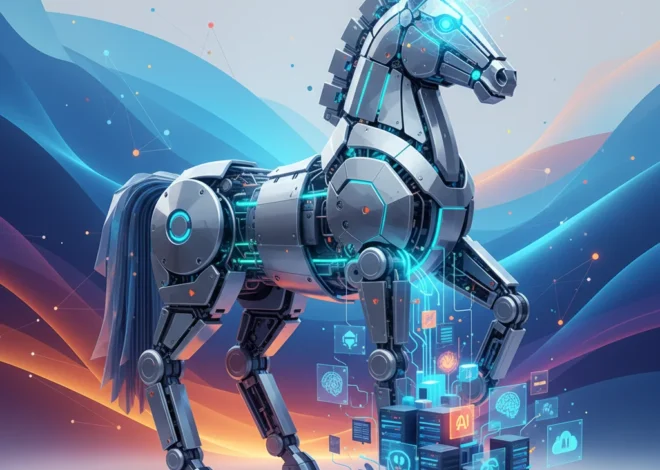
Beyond the Digital Firewall: How AI is Building a Fire-Proof Future
We live in a world of smart devices, intelligent assistants, and cloud-powered everything. We install digital firewalls and sophisticated cybersecurity software to protect our data, our most valuable asset in the modern economy. But what about the physical walls that protect us? The ones in our homes, our offices, the data centers that house the cloud itself? For decades, the technology meant to protect these structures from fire has been a dirty secret: effective, but often dangerously toxic.
The traditional approach to fire resistance has involved treating materials like wood, foam, and textiles with chemical cocktails, most notably brominated flame retardants (BFRs). While they do slow the spread of flames, these chemicals come with a heavy price. They leach into the environment, accumulate in our bodies, and have been linked to serious health issues. It’s a classic case of the cure being almost as bad as the disease. But what if we could design fire protection at a molecular level, creating materials that are inherently safe without the toxic side effects? A recent breakthrough, highlighted by the BBC, shows this future isn’t just possible—it’s already being built. And the tools making it happen are the same ones revolutionizing the tech industry: artificial intelligence, machine learning, and cloud computing.
The Burning Problem with Yesterday’s Solutions
To appreciate the magnitude of this innovation, we first need to understand the flaws of the old guard. For years, BFRs were the industry standard. They were mixed into everything from the insulation in our walls to the casings of our electronics and the foam in our furniture. Their job is to interfere with the chemical reactions of combustion, making materials harder to ignite and burn.
However, the dark side of these chemicals has become increasingly clear. Studies have shown they don’t stay put. They escape into the air as dust, contaminate soil and water, and build up in the food chain. For humans, exposure has been associated with thyroid problems, developmental issues in children, and even cancer. This has led to widespread bans and regulations, forcing industries to find alternatives. The problem? Many of the replacements have been just as problematic, a phenomenon known as “regrettable substitution.” We’ve been stuck in a cycle of replacing one toxic chemical with another slightly different, but equally concerning, one.
This isn’t just an environmental or health issue; it’s a technology problem. The traditional method of discovering new materials has been painfully slow, relying on manual experimentation, educated guesses, and a heavy dose of trial and error. This iterative, analog process is ill-suited for solving complex, multi-variable problems like creating a substance that is fire-resistant, non-toxic, durable, and affordable. We needed a new paradigm.
O2's Pricing Fiasco: A Masterclass in What Not to Do for SaaS and Tech Startups
The Breakthrough: Intelligent, Non-Toxic Fire Blocking
Enter the world of materials informatics and AI-driven discovery. The new fire-blocking treatment is a perfect example of this new approach. Instead of a brute-force chemical additive, it’s an elegant, bio-inspired solution. Researchers have developed a “polyelectrolyte” treatment, which sounds complex but is based on surprisingly simple and abundant materials.
As the source article explains, this treatment creates an ultra-thin coating—nanometers thick—that forms a protective char layer when exposed to heat. This layer cuts off the oxygen supply to the material underneath, effectively smothering the fire before it can truly start. The ingredients are remarkable: they can be derived from substances like chitosan (found in shrimp and crab shells) and even DNA. The result is a fire-retardant system that is not only highly effective but also completely non-toxic and environmentally benign.
This is where the connection to the tech world becomes crystal clear. This kind of breakthrough doesn’t happen by accident in a lab anymore. It’s the result of a convergence of disciplines, powered by massive computational resources.
The Tech Stack Behind the Material Revolution
How do you go from an idea like “a non-toxic coating” to a functional, market-ready product? You build a technology stack, just like you would for a software application. But instead of code and servers, the components are algorithms, simulations, and automated labs.
1. Artificial Intelligence and Machine Learning: The Digital Architect
The core of modern materials discovery is artificial intelligence. Scientists and startups in this space use machine learning models to sift through vast databases of chemical compounds. These AI systems can predict the properties of a theoretical material—its heat resistance, its toxicity, its molecular stability—before a single gram of it has ever been created. This is a game-changer. It turns the slow, expensive process of physical experimentation into a rapid, iterative digital design loop. An AI can run millions of simulations on the cloud, exploring a universe of molecular combinations that would take a human researcher millennia to test manually.
2. SaaS and Cloud: The Collaborative Laboratory
This AI-powered research doesn’t happen on a single laptop. It requires immense computing power, which is where the cloud comes in. Furthermore, specialized SaaS (Software as a Service) platforms have emerged to manage this entire workflow. These platforms, often called Materials Informatics platforms, integrate AI modeling, data management, and lab experiment tracking into a single, collaborative environment. A chemist in one lab can use the software to design a compound, send the instructions to an automated synthesis robot, and have the results and analysis available to a colleague across the world in near real-time.
3. Automation and Programming: The Robotic Chemist
Once the AI has identified promising candidates, automation takes over. Robotic arms and liquid handlers, guided by custom programming, can precisely mix chemicals, apply coatings, and run tests for flammability and toxicity. This removes human error, increases throughput by orders of magnitude, and generates the high-quality, structured data needed to feed back into the machine learning models, making them even smarter for the next round of discovery. It’s a virtuous cycle of digital design and physical validation.
To illustrate the shift, consider the old vs. new paradigms in developing fire-resistant materials:
| Aspect | Traditional Approach (e.g., BFRs) | AI-Driven Approach (e.g., Polyelectrolytes) |
|---|---|---|
| Discovery Method | Manual trial-and-error, serendipity | AI/Machine Learning simulations, predictive modeling |
| Core Technology | Wet lab chemistry, bulk additives | Materials informatics, nanocoatings, SaaS platforms |
| Development Cycle | Years to decades | Months to years |
| Key Challenge | Balancing efficacy with toxicity | Data quality, model accuracy, scaling production |
| Innovation Driver | Chemical engineering companies | Interdisciplinary teams, deep tech startups |
A Lesson from Cybersecurity: From Brute Force to Intelligent Defense
For tech professionals, perhaps the best analogy for this shift is the evolution of cybersecurity. In the early days, our primary defense was a simple, brute-force firewall. It was a static wall that blocked known bad ports and protocols. This is like the old BFRs—a heavy-handed approach that worked against simple threats but was inflexible and had significant performance overhead (collateral damage).
Today, modern cybersecurity is about intelligent, adaptive defense. We use AI-powered systems that analyze behavior, detect anomalies, and respond to zero-day threats in real-time. It’s a precise, multi-layered, and intelligent system. The new generation of fire-blocking coatings is the physical equivalent. Instead of saturating a material with a toxic chemical (the brute-force method), it applies a nano-thin, intelligent layer that only activates when a specific threat (heat) is detected. It’s targeted, efficient, and has no negative side effects during normal operation. This parallel highlights a profound trend: the principles of advanced software and network security—intelligence, adaptability, and precision—are becoming the guiding principles for solving our biggest physical challenges.
The New Tech Arms Race: Inside China’s EV Blitz and the US Scramble for Critical Minerals
This approach has implications far beyond fire safety. The same AI-powered innovation engine can be used to design:
- Lighter, stronger composites for aerospace and electric vehicles.
- Self-healing concrete that repairs its own cracks.
- Biodegradable plastics that reduce ocean pollution.
- More efficient materials for solar panels and batteries.
Here’s a look at the modern tech stack that enables this type of physical-world innovation:
| Layer | Technology Components | Function in Material Science |
|---|---|---|
| Computational Layer | AI/Machine Learning Models, Quantum Chemistry Simulations | Predicts material properties, identifies promising molecular structures. |
| Platform Layer | Cloud Infrastructure (AWS, Azure, GCP), SaaS for R&D | Provides scalable compute power and collaborative software for managing research. |
| Automation Layer | Robotic Synthesis, High-Throughput Screening, Custom Programming | Physically creates and tests AI-designed materials at high speed. |
| Data Layer | Material Databases, Sensor Data, Lab Results | Feeds real-world results back into the AI models to improve future predictions. |
Building the Future, Safely and Sustainably
The development of non-toxic, high-performance fire-blocking chemicals is more than just a scientific curiosity. It’s a powerful signal that the digital revolution is finally and fully merging with the physical world. The tools and mindsets that have defined the tech industry for the past 20 years—agile development, data-driven decisions, and a focus on elegant, efficient solutions—are now being applied to solve fundamental challenges in how we build, power, and protect our society.
For entrepreneurs and startups, this is a clarion call. The next trillion-dollar companies may not be building social networks, but rather foundational technologies for a more sustainable and resilient physical world. For developers and tech professionals, it means your skills in programming, AI, and cloud architecture are no longer confined to the digital realm. They are becoming the critical enablers for the next industrial revolution. According to one expert in the BBC report, these new materials could be commercially available within a few years, marking a tangible step toward safer buildings for everyone.
We are moving beyond simply fire-proofing our buildings to making them intelligently and inherently safe, from the molecule up. The same way we’ve moved beyond basic antivirus to intelligent cybersecurity, we’re now building a future where the walls around us are just as smart and safe as the data flowing within them.


